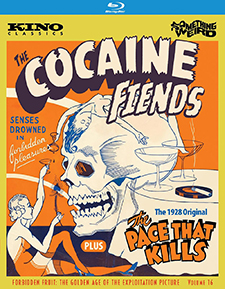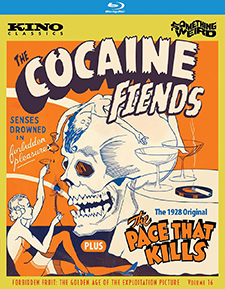Cocaine Fiends, The/The Pace That Kills (Blu-ray Review)

Director
William A. O’Connor/Norton S. ParkerRelease Date(s)
1928/1935 (July 23, 2024)Studio(s)
Willis Kent Productions (Kino Classics/Something Weird Video)- Film/Program Grade: C+
- Video Grade: A-
- Audio Grade: A
- Extras Grade: A-
Review
Included as an extra feature on Kino Classics’ The Cocaine Fiends/The Pace That Kills is a 1973 re-release trailer for The Cocaine Fiends, when it was distributed by the then relatively new distribution company New Line Cinema. They had successfully reissued Reefer Madness (1936) to college campuses and as midnight shows to great success, contemporary audiences regarding such films as high camp, pictures to be laughed at for their dated drug slang and melodramatic excesses.
What’s most surprising looking at the silent film The Pace That Kills (1928) and its talkie remake, The Cocaine Fiends (1935), originally released as The Pace That Kills also, is that, restored on Blu-ray using a 4K scan of the original negative (presumably for the remake) and a 2K scan from a 35mm print (for the silent version?), one can measure these works against other low-budget films from the period, against which both stack up rather favorably. If New Line’s trailer is any indication, what they released didn’t look any better than the cheapest of public domain releases during the early days of VHS, all scratched up and blurring nth-generation dupes. Further, where many like-minded exploitation films of the 1920s-‘40s are shoddy and crude to the point of being unwatchable, both films here are cheap but professionally made, comparing favorably to “legitimate” if cheap Poverty Row films from the same period. In short, they’re actually pretty good for what they are.
Headlining this double-bill, The Cocaine Fiends opens with drug pusher Nick (Noel Madison) ducking into a roadside café to avoid pursuing cops. There he meets waitress Jane Bradford (Lois January), quickly charming the naïve young woman with promises of taking her to the “big city” while offering her “headache powder”—in fact, cocaine. She’s soon addicted, and working as a showgirl under the stage name “Lil” at one of Nick’s nightclubs.
After a year passes with no word from Jane, her brother, Eddie (Dean Benton) moves to the city to look for her. (Throughout the film are many interesting Los Angeles locations.) While working at a drive-in restaurant, he, too, becomes hooked on dope through his girlfriend, waitress Fanny (Sheila Bromley). They’re soon fired from that job and unable to find new work, Eddie suffering from severe withdrawal symptoms and Fanny pregnant. Meanwhile, carefree platinum blonde Dorothy (Lois Lindsay) ignores the advice of her wealthy father (Frank Shannon) and with boyfriend Dan (Charles Delaney) visit Nick’s Dead Rat Club, a last-stop nightclub where Nick decides to “recruit” Dorothy as hophead Jane’s replacement. (The Dead Rat Club seems quite popular, despite its unappetizing name.)
Though undeniably an exploitation picture, The Cocaine Fiends doesn’t exaggerate the drug’s effects the way Reefer Madness goes overboard with its cautionary tale of marijuana. There are no shots of anyone actually snorting the stuff, but the euphoria various characters experience seems relatively accurate, as do the effects of withdrawal. Not long before the two films were made, after all, cocaine was considered medicinal and even sold in drug stores. Both it and the silent version err in suggesting a cocaine addict in withdrawal could find relief using opium, but for the most part the picture is fairly medically accurate for what it is.
Some of the dialogue has dated badly—“Tonight I’m gonna take you on a sleigh ride with some snow balls!”—but other scenes contemporary audiences laugh at, such as when Jane laments to Eddie, “It’s too late for me; a girl can’t go back,” play accurate to the time in which the picture was made. It’s also dramatically sound, opening with a car chase, and introducing three sets of characters who converge for the finale. Only a long musical interlude, several nightclub numbers, slackens the pacing.
It’s also surprisingly professionally made. Many of the cheapest exploitation pictures of this era used actors with few if any other film credits, but The Cocaine Fiends is populated with experienced actors, many with long careers. Most of these actors worked primarily in Poverty Row productions for companies like Monogram and PRC and/or in serials, but many also appeared in small, usually uncredited parts in bigger studio fare. For many the most recognizable name (if not face) is Frank Shannon, cleanshaven here, who would soon go on to play Dr. Zharkov in Universal’s three Flash Gordon serials. Star Lois January appeared in scads of B-Westerns and after that worked steadily on television as late as a 1987 episode of The Law and Harry McGraw. She even turns up as a citizen of Emerald City in The Wizard of Oz, visible holding a cat. Noel Madison was busy appearing as gangsters for big and small studios alike, including roles in Little Caesar, G-Men, and even several Laurel & Hardy comedies.
All told, The Cocaine Fiends is generally better-made than many Poverty Row offerings. Compared to, say, the average PRC horror film with Bela Lugosi or Monogram’s later Charlie Chans, this has better production values, camerawork, editing, etc.
Bits of stock footage from the 1928 silent version turn up, yet I was also surprised how different the silent film version is. It has the same basic story and characters but all of the particulars are different. I had expected something like the John Wayne B-Westerns made for Warner Bros., all remakes of Ken Maynard silent Westerns that incorporated as much stock footage from the earlier films as possible. That’s not the case here at all, and the silent version is likewise polished and professional, if cheaply made.
Kino’s The Cocaine Fiends/The Pace That Kills Blu-ray—Vol. 16 in their Forbidden Fruit: The Golden Age of the Exploitation Picture collection—presents a 63-minute cut of the former. A few short scenes use lesser film elements, but most of it looks great. There’s a short scene, maybe 20 seconds, that has audio but no picture, the presentation using still photos a la the reconstruction of the 1954 A Star Is Born. The 64-minute silent film includes a 2024 musical score composed and performed by Meg Morley. Both features are on one Region-Free disc.
Extras consist of audio commentaries by writer Eric Schaefer on The Cocaine Fiends and film scholar Anthony Slide on The Pace That Kills. In addition to the aforementioned 1973 re-release trailer for The Cocaine Fiends, also included is what’s billed as “alternate opening titles,” but that turns out to be an excruciatingly long text prologue with no actual credits.
Better made than what one might have expected, The Cocaine Fiends and The Pace That Kills are certainly watchable and well worth a look.
- Stuart Galbraith IV

